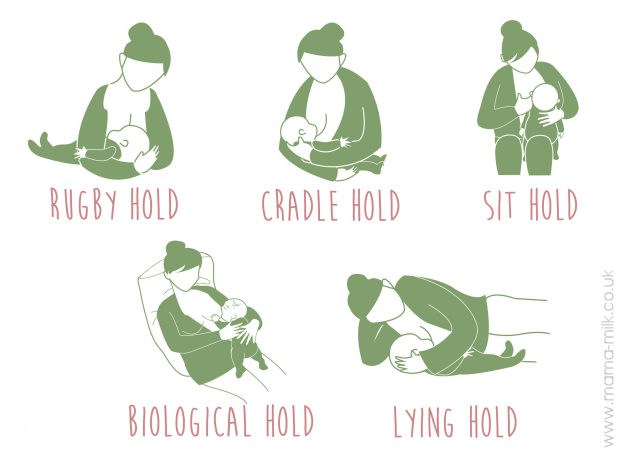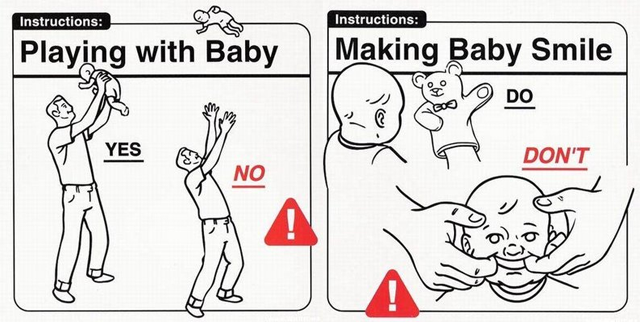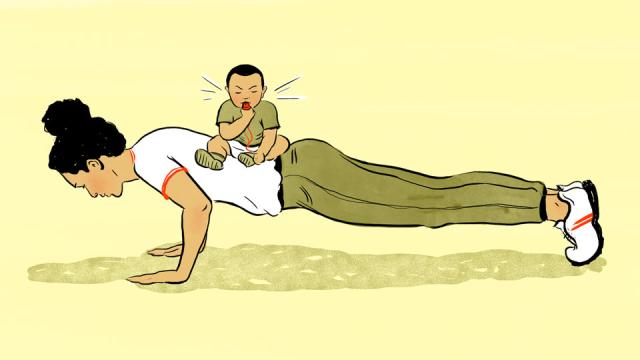For such a small thing, babies can be downright intimidating, especially when you’re a first-time parent. Infants don’t come with instruction manuals, so here’s a Baby 101 survival guide for those delicate and trying first months of living with a newborn.
Pictures: Sarah G, Mama Milks
Like many first-time parents, the moment I learnt my baby was on her way, I started devouring every parenting book I could find, each book with hundreds of pages of (sometimes conflicting) advice. Boiling all of that down, there are only a few essential skills new parents need to learn. Here’s a cheat sheet.
1. How to Hold a Baby
Minutes after the baby is born, he or she will be thrust into your arms — a delicate, daunting moment. The basic rule you need to know: always support the baby’s head and neck while also supporting his or her body. Newborns’ neck muscles aren’t developed yet and their heads are heavy (and wobbly!). So when picking the baby up, cradling her or carrying her, always support her head and body at the same time with both your hands — at least for the first three months until the baby can hold her head up on her own.
That’s all you really need to know. Dads Adventure, however, elaborates with a variety of baby holds that are “best for men” (but useful for women as well):
- Carry your baby so his chest is against yours and his head is resting on your shoulder. [Editor’s note: Also support the head.] A very good position for burping, and babies like it because they can look at things over your shoulder.
- Sit her on your lap with her back resting against you and your hand holding her chest. Then rock back and forth. If you have a rocking chair, all the better.
- The forearm lift will often calm a fussy baby. Bend one arm and place your baby, tummy down, along the length of your forearm, with his head resting in your open hand and his legs straddling your arm. Bring your arm close to your body for security and then stroke or gently pat his back with your other hand.
- Laying him tummy down across your knees will also often calm a fussy baby. Stroke or gently pat his back.The best hold is laying your baby across your chest so he can fall asleep listening to and feeling your heartbeat.
It’s even better if the baby gets lots of skin-to-skin contact with you for deeper bonding.
2. How to Breastfeed or Bottle-Feed a Baby

During the first few months, all anyone is going to be thinking about (besides sleep, below) is feeding the baby. Are you breastfeeding? Are you bottle-feeding? Is the baby feeding enough? Newborns want to nurse every 2-3 hours; slightly older babies, every 3-4 hours. To survive this on-demand feeding phase you’ll need a strategy.
How to breastfeed comfortably: If you’re nursing, how you hold the baby while breastfeeding can make or break the arrangement. In the hospital, the nurses will help you get started breastfeeding, but don’t be concerned if it takes some time and trial-and-error to make sure you’re nursing effectively and the baby latches on properly. La Leche League suggests five breastfeeding positions to consider and tells us how to make sure the baby is latched on well:
Good latch-on checkpoints for your baby include:
- his nose is nearly touching your breast, that is, no further away than a credit card edge his lips are flanged at least ½ inch of your breast around the base of your nipple is in his mouth.
- If it’s uncomfortable or painful for you and the baby doesn’t seem to be getting any milk, something’s wrong, so try again: gently place your finger in the baby’s mouth, between his gums, to detach him and try again.
- A baby who is offered the breast will suck without swallowing as he positions the nipple in his mouth and tells your breast he is ready for the milk to let down. When he begins to receive milk, you will see his jaw working all the way back to his ear. His temples will wiggle. You will also hear him swallowing, quickly at first, then more slowly, as his appetite is satisfied.
You’ll be stuck in this position for 20 to 30 minutes each feeding, so make sure you’re comfortable (and have a good book or other distraction in hand). A breastfeeding pillow or regular pillow can help position your baby more comfortably on your lap. And when you’re sleep-dragging yourself out of bed for another late-night feeding, it helps to learn how to breastfeed while lying on your side. Breastfeeding can be daunting at first, but armed with the right knowledge, it will become easier over time.
How to bottle feed a baby: When feeding a baby with a bottle, you likewise want to make sure the baby is drinking comfortably. Tilt the bottle about 45 degrees, or at least until the nipple gets full of milk or formula so there’s no additional air coming through (otherwise you’ll end up with a gassy baby!). Like breastfeeding, there are a few different positions you can use to bottle feed a baby.
Before the baby arrives, you’ll also want to sterilise all the bottles and tubes and parts per your manual, but afterwards you can just wash these things with soap and warm water.
3. How to Get the Baby to Sleep (and Sneak in Some Sleep Yourself)
Perhaps the most important skill you and your baby need to master is how to go the f**k to sleep, on demand. You might be used to an uninterrupted eight hours of sleep every night, but when baby comes around you’re in for a big shock.
Newborns wake to feed every two to three hours, so you’ll need to work in shifts to make this work as a team — e.g. dad waking to bring the baby to mum for every two or three feedings, and then mum getting up for two or three feedings while dad sleeps.
How to swaddle the baby: Swaddling is our best defence against unhappy, sleepless, crying babies — because babies want to be swaddled and often cannot sleep unless swaddled. Swaddling makes babies feel like they’re being tightly cuddled in the womb, so swaddle as tightly as you can.
If you swaddle too loosely or the wrong way, you will induce the baby’s wrath. (I swaddled my daughter too loosely once, trying a not very good sleepsack/wrap, and it was a disaster — tiny baby legs and arms flailing all over the place, furiously.) Check out the video above to see how you swaddle a baby. Make sure you have enough fabric to wrap around the baby multiple times.
4. How to Keep Baby (and Yourself) Clean
Babies are usually clean, but they are prone to scratching themselves with their little sharp newborn nails, getting nappy rashes, and, sometimes, having explosive poops. They will also spit up and sometimes full-on puke on you. There’s nothing you can really do about it but prepare yourself for the worst.
How to bathe a baby: In the first couple of weeks, you are the Protector of the Umbilical Cord. It cannot get wet, so you’ll have to give the baby sponge baths for the first few weeks, which involves wrangling the slippery little creature in your sink or tub and gently washing with a sponge or washcloth every few days until the umbilical cord falls off (in one to four weeks), or, if the baby is circumcised, the circumcision heals (up to four weeks).
How to change a nappy: Nappy changing isn’t that much of an advanced skill either, but it does take some preparation if you don’t want to get sprayed inadvertently. You’ll probably need to change the baby or check the nappy: after every feeding, when your baby wakes up, and before you go out with your baby. Change the baby as soon as possible after every bowel movement.
Here’s a video that shows how to protect yourself and your baby while changing the nappy: Put the new nappy under the one you’re removing and quickly swap to prevent sprays or spills.
Also, keep bottles and other things out of reach from the changing area, and use the changing table/pad strap to prevent the baby from rolling off the table. It happens!
How to clean spit ups, vomit and poop blowouts: Get comfortable with gross stuff, new parents. Nappy explosions and “up the back” pooping are part of the initiation into parenthood. Unless you see signs of blood, however, explosive poops are usually normal.
If you need to get baby vomit out of your couch, vinegar is probably your best solution, according to First Choice Carpet Cleaners. Baby poop could use some Oxi-Clean hot water soaking and/or treatment in the sun. Otherwise, it’s just wash as usual.
5. Survival Skills: Getting to Know What Baby Wants and Needs

The first few months are all about getting to know your baby, nappy blowouts or not.
How to interpret your baby’s cries: As you know, babies cry to communicate. Sometimes it might seem like the baby’s crying for no obvious reason, but to understand the baby better — and, importantly, stop the crying — start thinking of the basics: Is the baby hungry? Does the baby need a nappy change? Is the baby too hot or cold? Need a nap? Or maybe just want some soothing from you? It helps to keep a log of feeding and nap times so you can narrow down that’s wrong. If your baby has colic, Dr Karp’s five S’s can help: swaddle, place the baby on her side or stomach, make shushing sounds, make swinging motions, and give the baby something to suck on. (I had a big exercise ball that I would bounce on while holding my daughter that always worked like magic to stop her crying.)
The worst, however, is when baby is overstimulated and tired but a caregiver interprets the cries as meaning “Baby wants to be juggled and cooed at very loudly.” You’ll know your baby’s cues better than anyone else, so don’t be afraid to remove the baby to the nursery for some shut-eye or quiet time when needed. Nap when the baby naps!
Helping a gassy or fussy baby: Babies can swallow lots of air when nursing, which can lead to gas and fussiness. That’s why it’s often recommended to burp the baby when switching breasts during breastfeeding or for every 60mL-90mL she gulps down. You can do this with the baby laying belly-down on you lap as you pat her back or with your baby facing your chest and her chin on your shoulder. There’s also a baby yoga technique to relieve gas.
How to perform infant or toddler CPR: A good Lamaze or pre-parenting class will teach you the life-saving skill of CPR. While it’s best to get some real-life practice on a doll, the video below thoroughly explains how to do infant CPR using the latest C-A-B-D guidelines.
Know how and when to take a break: Finally, taking care of a newborn can be overwhelming. If you get to the point where you feel like you might be losing your mind, ask for help. Don’t be afraid to put the baby in the crib, even if she’s crying inconsolably, and walk away for a few minutes to clear your head and regain control. Knowing how to take care of yourself at this time is an important skill as well.
Congrats, new parents. You’re going to pass baby boot camp just fine.

Comments
One response to “Baby Boot Camp: The Skills Every New Parent Needs To Learn”
Swaddling My children just seemed to make them angry. If you wrapped them up they would scream but if you just let their arms out and wrapped up the rest they would go to sleep. Even the experts seemed confused by it, every time a new social worker or whatever came by they would say we were doing it wrong. They would wrap the babies up and the babies would scream and what not, then after an hour of them trying I would Swandle my way and five minutes later an asleep baby.
My last baby must not have read the SIDS brochure because she would not sleep on her back, only on her side. The nurse said some babies are a pain like that and to just let her fall asleep on her side and then slowly roll her on her back. She is also the baby that failed sleep class. She would sleep great at night but would not sleep at all during the day so eventually we went to sleep class, it’s a whole day program where they look at your non sleeping baby to see what YOUR doing wrong. At the end of the day they just shrugged and said they don’t know what the prblem is…..we just have a non napping baby for some reason.